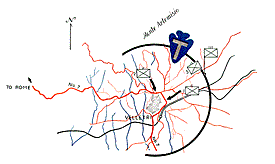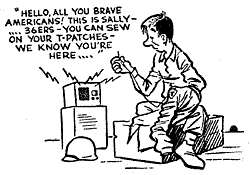|
|||
|
|||
VI Velletri and the Fall of Rome |
|||
We closed into our assigned area at the Anzio Beachhead on May 22, 1944, moving in LST's, LCI's and other landing craft from Naples to Anzio. Our 36th Division was in VI Corps reserve initially. The attacks launched by the American Fifth and British Eighth Armies on the southern front on May I I, 1944, had met with considerable success. Our troops there had overrun the famed "Gustav Line," Cassino had fallen, and advances had been made deep into the Liri Valley where they were engaged in the reduction of the "Adolph Hitler Line." Now a timed attack was launched from our foothold at Anzio, coordinated with the drive from the south, breaking out along the entire perimeter of the beachhead, with the objective of cutting Route No. 7, the famed Appian Way, and Route No. 6, Via Roma, the two main arterial routes of supply and escape for the Germans in the south. Our arrival at the Anzio Beachhead could hardly have been called secret. "Sally," reliable as ever, broadcast her welcome to us. Before us the beachhead at Anzio extended for about 14 miles, from the Moletta. River along the north, south to the Mussolini Canal, varying in penetration from five to nine miles. The terrain was generally flat, rising gently and becoming more rolling as it stretched inland toward the ring of mountains that boxed it in against the sea.
On May 27, 1944, we began to advance gradually in the sector in the direction of Velletri, in order to maintain contact with elements on our right. The advance was made by alternate displacement of battalions which were encountering only light resistance. On May 28, 1944, we took 18 prisoners after only brief skirmishing. On this date the line extended approximately southwest to northeast, about two and a half miles from the southeast corner of Velletri. The advance was continued after repelling two counterattacks supported by tanks, and on May 30, 1944, we were relieved in line by the 36th Engineer (Combat) Regiment, in preparation for execution of the Division Commander's plan for the envelopment of Velletri. Our Division Commander, believing that the Lanuvio-Velletri-Artena line of the Germans was vulnerable, had conceived the brilliant and daring plan of infiltrating two regimental combat teams into the high ground northeast of Velletri. This was to be done through terrain without roads and through an enemy line believed to be lightly held. Our regiment, operating on the Division's left flank, was to by-pass Velletri to the north, cut off the enemy-held roads leading out of the city, and assault the strongpoint from two sides in a coordinated attack. One of our battalions was to maintain blocks on the Velletri-Valmontone road and secure the flanks of the Division during the infiltration of the other two regiments through the gap. The movement of our battalions to accomplish our assigned mission was begun at 1600 hours, May 30, 1944. Slowly they advanced along the lower slopes of Mount Artesemo and north of the Velletri road against infiltrating enemy detachments and heavy artillery fire from Velletri. Snipers seemed to be everywhere. The roads were dry and dust rolled in clouds behind our moving trucks and vehicles and settled in deep coats on our faces. While one of our liaison officers was at the Division Command Post, a sniper began shooting into the command group. The Commanding General, turning impatiently to his startled staff, started moving toward the sniper, "Come on. Come on. Let's go." Our liaison officer jumped forward with his carbine. The General laid a restraining hand on the Lieutenant's shoulder. "What are you going to do with that, son?" he asked smilingly, indicating the carbine. "Are you going to club him with it?" The embarrassed officer looked down and saw his carbine was useless, having been completely choked with the heavy dust.
|
|||
Copyright © 1945, 1998 141st Infantry Regiment
Association. |


 Moving on the night of May 25, 1944, we left the area
three miles northeast of Anzio and closed into position about one mile northeast of
Cisterna. Soon after moving into the new location, we began to shift into a defensive
position approximately two-thirds of a mile north of Cisterna and running generally north
and south between the Castelle and Cisterna River beds, along a newly constructed trail
known as the "Purple Heart Path."
Moving on the night of May 25, 1944, we left the area
three miles northeast of Anzio and closed into position about one mile northeast of
Cisterna. Soon after moving into the new location, we began to shift into a defensive
position approximately two-thirds of a mile north of Cisterna and running generally north
and south between the Castelle and Cisterna River beds, along a newly constructed trail
known as the "Purple Heart Path."